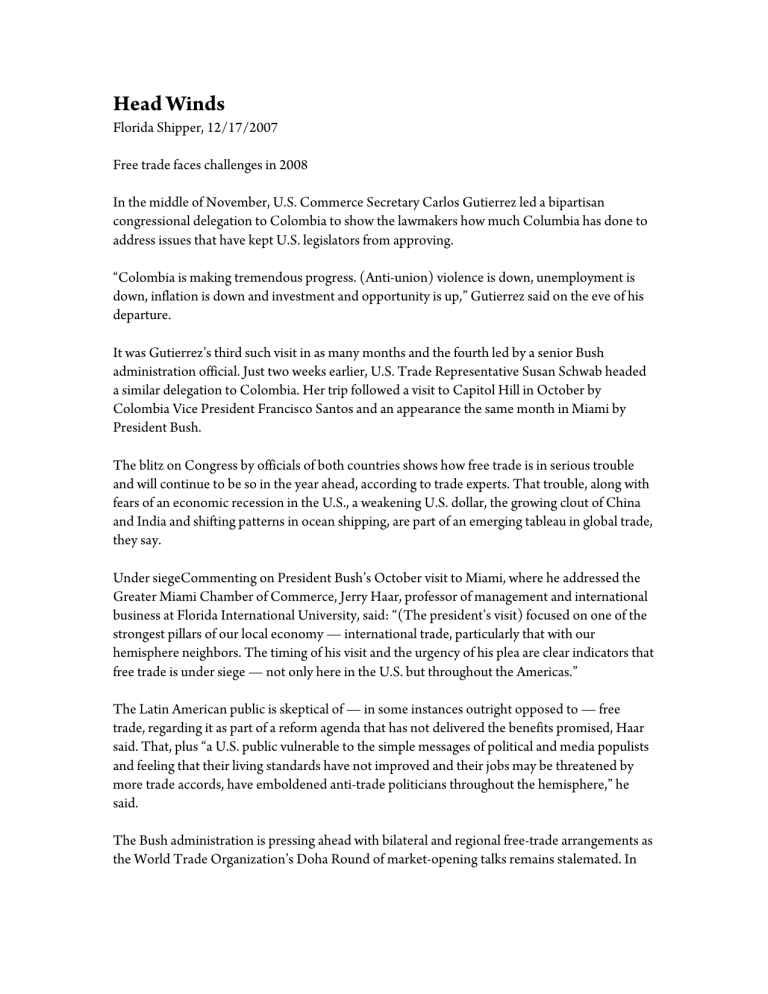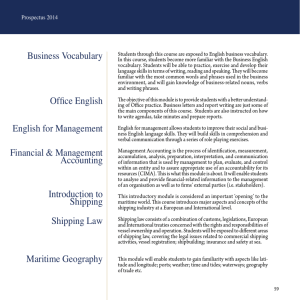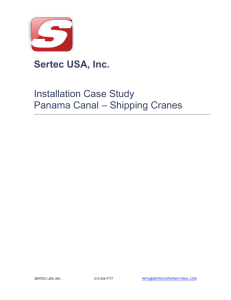Head Winds - Florida International University College of Business

Head Winds
Florida Shipper, 12/17/2007
Free trade faces challenges in 2008
In the middle of November, U.S. Commerce Secretary Carlos Gutierrez led a bipartisan congressional delegation to Colombia to show the lawmakers how much Columbia has done to address issues that have kept U.S. legislators from approving.
“Colombia is making tremendous progress. (Anti-union) violence is down, unemployment is down, inflation is down and investment and opportunity is up,” Gutierrez said on the eve of his departure.
It was Gutierrez’s third such visit in as many months and the fourth led by a senior Bush administration official. Just two weeks earlier, U.S. Trade Representative Susan Schwab headed a similar delegation to Colombia. Her trip followed a visit to Capitol Hill in October by
Colombia Vice President Francisco Santos and an appearance the same month in Miami by
President Bush.
The blitz on Congress by officials of both countries shows how free trade is in serious trouble and will continue to be so in the year ahead, according to trade experts. That trouble, along with fears of an economic recession in the U.S., a weakening U.S. dollar, the growing clout of China and India and shifting patterns in ocean shipping, are part of an emerging tableau in global trade, they say.
Under siegeCommenting on President Bush’s October visit to Miami, where he addressed the
Greater Miami Chamber of Commerce, Jerry Haar, professor of management and international business at Florida International University, said: “(The president’s visit) focused on one of the strongest pillars of our local economy — international trade, particularly that with our hemisphere neighbors. The timing of his visit and the urgency of his plea are clear indicators that free trade is under siege — not only here in the U.S. but throughout the Americas.”
The Latin American public is skeptical of — in some instances outright opposed to — free trade, regarding it as part of a reform agenda that has not delivered the benefits promised, Haar said. That, plus “a U.S. public vulnerable to the simple messages of political and media populists and feeling that their living standards have not improved and their jobs may be threatened by more trade accords, have emboldened anti-trade politicians throughout the hemisphere,” he said.
The Bush administration is pressing ahead with bilateral and regional free-trade arrangements as the World Trade Organization’s Doha Round of market-opening talks remains stalemated. In
addition to the Colombia FTA, agreements with Panama and South Korea are struggling for approval in Congress.
The House and Senate have passed a U.S.-Peru Free Trade Agreement. The Panama FTA may well squeak through, Haar said, but chances of an accord with Colombia are far less certain.
Prospects for the South Korea agreement are even dimmer because of a perception that it does not provide enough access to the Korean market, while giving Korean companies greater access to the U.S. market.
Congress will resume deliberations on all the FTAs when it reconvenes in February.
Dollar daysAnti-free-trade sentiment will hardly stop the growth in world trade, however. The
World Bank predicts global trade in goods and services could rise more than threefold to $27 trillion by 2030 and trade as a share of the global economy will rise from one-quarter today to more than one-third. Roughly half of the increase is likely to come from developing countries, according to the bank.
With the weak dollar making U.S. goods cheaper for overseas buyers, the U.S. is poised to benefit from that growth, free trade or not.
“The weak U.S. dollar will cause people to readjust their sourcing and business strategies. Sellers who depend on (the U.S.) market will not be able to sell as much. Those currencies that are stronger will buy more. That bodes well for U.S. exports,” said Thomas G. Travis, managing partner at Sandler, Travis & Rosenberg P.A., a customs and international trade law firm, and chairman of Sandler & Travis Trade Advisory Services.
The weak dollar already has pushed U.S. exports to all-time highs, boosting prospects for shrinking the country’s trade deficit, which last year exceeded $800 billion. The U.S. trade deficit decreased to $56.5 billion in September from $56.8 billion in August, as exports increased more than imports. Exports increased to $140.1 billion in September from $138.6 billion in August.
Exports of goods were $100.2 billion in September, up from $99 billion in August.
For the first nine months of the year, exports of goods grew 11.4 percent to $851 billion, compared with $764 billion in the same period last year, according to the Census Bureau, while imports increased only 0.4 percent. Lower growth in imports resulted in a reduction in the deficit in the first nine months of 2007, to $583 billion from $620 billion in the same period last year. However, the trade gap may expand during the rest of this year as a result of skyrocketing oil prices.
“Further dollar depreciation is expected so exports will improve. The dollar will see steady declines through 2008 due to huge current account deficits,” said Robert West, managing director of maritime global trade and transportation at Global Insight Inc., Lexington, Mass., providers of economic and financial analysis, forecasting and market intelligence.
Michael Andrews, chief economist for PIERS Global Intelligence Solutions, a sister company of
Florida Shipper, said other factors expected to contribute to the further weakening of the dollar next year include the likelihood of reduced capital inflows in the wake of the subprime mortgage bust and the prospect of additional interest rate reductions by the Federal Reserve Bank.
Where the action is All bets for the biggest jump in trade activity are on developing markets, which have the fastest-growing economies.
“Developing countries that only two decades ago provided 14 percent of manufactured imports of rich countries, today supply 40 percent and by 2030 are likely to supply more than 65 percent.
At the same time, import demand from developing countries is emerging as a locomotive of the global economy,” the World Bank said.
Emerging economies are growing at annual rates above 4 percent, compared with rates of between 1 and 2 percent in the United States. Still, the International Monetary Fund predicts real gross domestic product growth either will slow or remain unchanged in 2008 in every region except sub-Saharan Africa, whose growth estimates are 6.1 percent in 2007 and 6.8 percent in
2008.
GDP is the total market value a nation’s output of goods and services. Exporters are a key of determinant of GDP growth.
“(The years) 2007 and 2008 are turning out to be considerably weaker than what we thought a year ago, and this is mainly the result of a much weaker U.S. economy,” West said.
“For ocean shipping, that means demand for containerized cargo is right now slipping. Without question, next year there will be growth. We’re not talking about a recession in ocean shipping at all. But we’re not expecting the 10 percent we used to see. Not in ’07 and not in ’08,” he said.
Nowhere will trade be more robust than in Asia, whose regional economy is expected to expand by 9.2 percent this year and 8.3 percent in 2008, according to the IMF. In China alone, real GDP growth is projected to be 11.5 percent this year and 10 percent in 2008, and in India, 8.9 percent this year and 8.4 percent next year.
In addition to the region’s rapid growth, most countries, including China, South Korea and
Japan, are cutting barriers among each other.
“One-third of the world’s container trade is intra-Asia,” West said.
Shipping lines are going where the action is. Zim Integrated Shipping Services Vietnam LLC, for example, commenced operations at the beginning of August. With an annual real GDP growth
rate of 8.2 percent, Vietnam is at the same time experiencing containerized growth exceeding 20 percent, Zim officials said.
In November, “K” Line Ltd. and MOL enhanced their Asia-Mexico/west coast South America container service, called New ANDES, with the addition of weekly direct calls at Qingdao in
China’s Shandong province. A major seaport, industrial center and naval base, Qingdao has the highest potential for growth in North China in terms of export cargo production, import cargo processing and local consumption, the carriers said. China + India = ChindiaChina’s foray into emerging markets will continue unabated, experts say.
According to Global Insight, Latin America could absorb 10 percent of China’s container exports by 2015, with strong growth in consumer products. As China expands its markets, the
U.S. becomes less important, the firm said.
“The importance of the United States as a percentage of China’s exports declines over time. The reason is that China is looking at the whole world as its marketplace,” West said. “When you look at Latin America as a market for China, you see that Latin America increases its share of
China’s exports over time. The volumes going to the United States, of course, will still be huge, but the growth will be faster from China to Latin America than from China to the United
States.”
West sees the potential for a strategic alliance between China and India, the giant of South Asia.
The resulting “Chindia” could be a formidable axis, with India focusing more on high-tech exports, West said.
“In India, you have the software developers, the robotics — all the brain power to develop the necessary systems for manufacturing — but then everything gets made in China. If the two countries talk to each other, they can work out an alliance where India is able to capitalize on its tremendous wealth of people and brain power and China will capitalize on what it does best — manufacturing and assembly,” West said.
Shifting routesIn January, the American Association of Port Authorities and the U.S. Maritime
Administration will convene a workshop in Tampa, Fla., covering shifting global trade routes and the implications of an expanded Panama Canal.
Plans are being implemented to build a new lane of traffic along the canal through construction of a new set of locks. The expansion, estimated to cost $5.25 billion and slated for completion in
2014, will double capacity and allow for longer and wider ships, the so-called New Panamax container ships of more than 12,500-TEU capacity.
“Expanding this crucial transocean shipping lane to accommodate more and larger ships presents a host of challenges and opportunities, ranging from increased trade to major new
investments in water- and land-side transportation infrastructure,” said Kurt J. Nagle, president and chief executive of the AAPA.
Mega-ships already are on order as shipping lines prepare for what some say will be a new era in ocean shipping.
“We foresee the new lane of traffic along the waterway influencing the future of shipping,” Dani
Kuzniecky, chairman of the board of directors of the Panama Canal Authority and minister of canal affairs, said at the seventh “Keeping the Americas Moving” conference in Panama in
November.
As with other shipping lines, Zim is vastly expanding its fleet. The Israeli carrier recently approved the purchase of eight ships from South Korea, with an option to buy one more, for delivery at the beginning of 2012. At 12,600 TEUs each, the capacity of the ships will be compatible with the characteristics of the Panama Canal once its enlargement is completed, Zim said. The purchase follows Zim’s order of 12 ships last year — eight of which are 10,000 TEUs and four are 8,200 TEUs — for delivery at the end of 2009 and beginning of 2010.
The widened canal and the larger ships it will accommodate will change patterns on the major east-west trade routes, notably the Asia-North America trades, according to experts.
With U.S. West Coast ports chronically congested, the canal will make East Coast ports more attractive for cargo moving into the U.S. Midwest, many predict.
Moreover, as West Coast port costs increase to pay for environmental compliance, shipping lines will look to other options, such as Mexico and Canada, West said.
Copyright © 2007 Commonwealth Business Media







